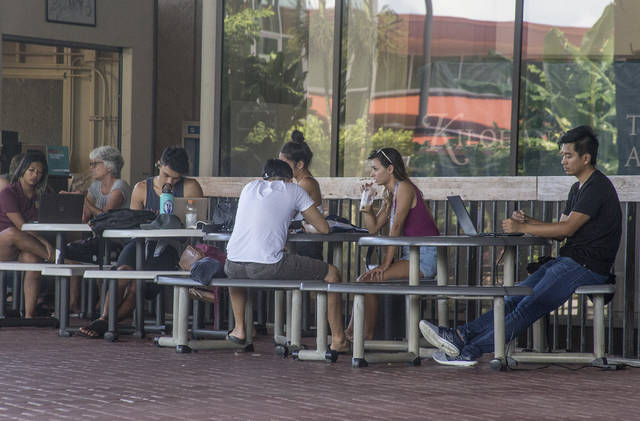Student populations declined again at the University of Hawaii at Hilo and Hawaii Community College, according to fall enrollment numbers released this week by the university system.
Enrollment figures show that UH-Hilo has 3,406 students enrolled, a 3.8 percent decrease from last year’s 3,539 students, while HCC has 2,632 students enrolled, a 6.6 percent decline from last year’s 2,819 students, the largest drop among community colleges in the UH system.
UH-Hilo’s student population has declined every year since 2012, when it peaked at 4,157 students after several years of growth. At HCC, enrollment has similarly dropped each year after peaking at 3,917 students in 2011.
Interim Chancellor Marcia Sakai said UH-Hilo anticipated a decrease in enrollment following Kilauea volcano eruption activity that began in early May in lower Puna, and university officials noticed a change in student responses, such as intents to enroll, immediately after May 3, which is when the eruption began.
“While we don’t know specifically the cause of our declining enrollment, we do know that low unemployment rates and UH-Hilo’s rising numbers of degrees and certificates earned would tend to reduce enrollment,” she said. “Potential students may choose to work while the job market is strong, and we are both encouraging and pushing students to complete their degrees in a timely way.”
HCC Chancellor Rachel Solemsaas said enrollment at the community college and the economy tend to have an inverse relationship.
HCC has been in “declining mode since the economy turned back around” following the recession of 2008, she said, adding that “when the economy is good, residents tend to go back to work.”
Although the decline matches at the system level, Solemsaas said the school did see “quite a drop for our college compared to prior years.”
HCC is looking by location where that enrollment decline has happened, she said, and “we are verifying the impact of the lava and eruption activity on enrollment.”
It could be that those displaced by lava are focused on recovery and economic stability, she said, and if that’s the case, HCC will look at how to support those students.
At UH-Hilo, efforts to improve retention have “positively affected” the number of students enrolled this fall who also were enrolled last spring.
“Early enrollments showed gains in excess of 8 percent higher than enrollment for the same date in the prior year, and were the highest in the system at that time,” Sakai said. “We see that the decrease in continuing students is significantly less than the prior year, indicating we experienced some success in our retention efforts.”
There were 2,154 continuing students this fall, compared with 2,256 last year, a 4.5 percent decrease.
According to a UH news release, despite the ultimate enrollment decline in the wake of worldwide news of the Kilauea eruption and flooding from Hurricane Lane during the first week of classes of the fall semester, UH-Hilo did, however, recruit a freshman class “almost as large as they did last year.”
The number of first-time freshmen at UH-Hilo totaled 414, which is down slightly from last year’s 419. Last year’s freshman group, however, was a 13.2 percent increase from 2016 counts.
Sakai also said the number of new students, comprised of graduate students and Early College students, grew by 20 percent. There were 326 first-time students this year compared with 271 in 2017, a 20.3 percent increase.
“This year, UH-Hilo lost ground among transfer students, more so than in previous years,” Sakai said. “We are still assessing the reasons for this in order to better direct our transfer recruitment efforts for the coming year.”
Transfer students totaled 421 this year compared to 513 in 2017, a 17.9 percent reduction.
The university depends on HCC as a “major feeder” for transfer students and fewer students are enrolling there, Sakai said.
“For potential students from other locations, such as the continental U.S., we believe that uncertainty regarding the eruption activities may have influenced their decision to attend UH-Hilo,” she said.
HCC saw declines in the total number of first-time freshmen (464), first-time students (394), transfer students (230) and continuing students (1,291), and only saw an increase in returning students, with a total of 253 this year compared to 242 last year.
According to Sakai, the lower student population at UH-Hilo means there will be a “small, negative impact” to the campus’ operating budget, “but we will continue to offer services to our students, unchanged and uninterrupted.”
Solemsaas said declining enrollment also will affect the HCC budget.
“So we are looking very closely on how we can further address any anticipated deficit resulting from reduced tuition revenue,” she said.
According to Solemsaas, there should be savings once solar panels at HCC’s Palamanui campus in Kailua-Kona are installed and operational. HCC also will “look closely at vacant positions,” she said.
A total of 51,063 students are enrolled throughout the University of Hawaii’s 10 campuses, a decline of 1.2 percent from last fall, according to UH.
Email Stephanie Salmons at ssalmons@hawaiitribune-herald.com.



